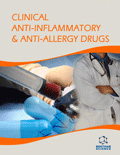- Home
- A-Z Publications
- Clinical Anti-Inflammatory & Anti-Allergy Drugs (Discontinued)
- Previous Issues
- Volume 2, Issue 1, 2015
Clinical Anti-Inflammatory & Anti-Allergy Drugs (Discontinued) - Volume 2, Issue 1, 2015
Volume 2, Issue 1, 2015
-
-
Real-life Experience of Clinical Efficacy of Omalizumab Use in the MiddleEast: Should We Also Be Concerned About Parasites?
Authors: Carla Irani and Olga NahasMore LessBackground: Omalizumab is a monoclonal anti-IgE antibody approved for the treatment of severe allergic asthma. There is increasing evidence in the literature of its usefulness in other allergic conditions such as chronic urticaria and nasal polyposis. Methods: Here in, we report a prospective case series of 52 adult patients in a tertiary university hospital, Allergy and Immunology Clinic: 36 with severe asthma, among them 6 wi Read More
-
Volumes & issues
Most Read This Month
Article
content/journals/caiaad
Journal
10
5
false
en


